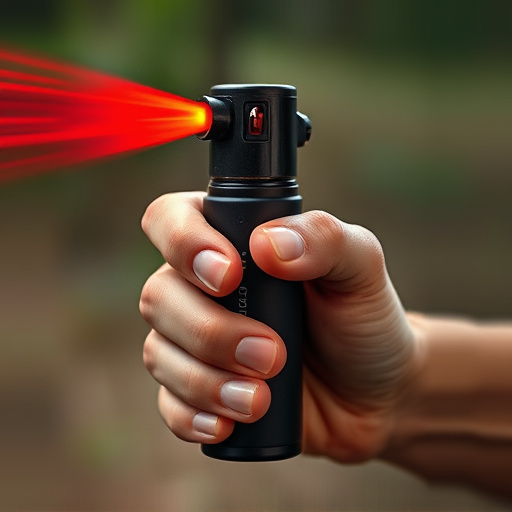Pepper spray, leveraging capsaicin from chili peppers, is a safe, non-lethal self-defense tool effective against assailants. Best delivery methods include hand-held sprays for broad coverage, aerosol canisters for fast, wide-range use in close encounters, and targeted foam sticks for tight spaces. Gel/liquid formulas offer better control but require more training. Understanding local laws regarding pepper spray ownership and usage is crucial. The ideal method depends on personal preference, intended usage, and safety considerations.
“Uncover the power of self-defense with inflammatory spray devices, a game-changer in personal safety. This comprehensive guide explores the world of pepper spray, its proven effectiveness against potential threats, and how modern delivery methods enhance your defenses.
From understanding the basics to uncovering innovative features, we’ll navigate the best pepper spray options tailored to your needs. Discover the top delivery methods, ensuring you’re prepared for any situation. Arm yourself with knowledge and choose wisely among the diverse range of self-defense tools available.”
- Understanding Pepper Spray: The Basics and Its Effectiveness
- Exploring Self-Defense Inflammatory Spray Devices: Features and Benefits
- Choosing the Best Pepper Spray Delivery Method for Your Needs
Understanding Pepper Spray: The Basics and Its Effectiveness
Pepper spray, also known as oleoresin capsicum (OC) spray, is a non-lethal self-defense tool designed to temporarily incapacitate an assailant by causing irritancy and pain. It works by targeting the eyes, nose, and respiratory system, making it difficult for the target to breathe or see clearly. The active ingredient, capsaicin, is derived from chili peppers and is known for its burning sensation. Understanding how pepper spray works and its effectiveness against potential attackers is crucial when considering it as a self-defense mechanism.
When it comes to the best pepper spray delivery methods, hand-held sprays are the most common and widely used. These devices typically contain a solution of capsaicin in a carrier oil and are designed to be easily operated by spraying directly into an assailant’s face. The effectiveness of pepper spray lies in its ability to create a cloud of irritants, ensuring that the target is affected even if they manage to avoid direct contact. Modern pepper sprays come in various strengths, with higher concentrations offering longer-lasting effects and increased range, making them powerful tools for personal safety.
Exploring Self-Defense Inflammatory Spray Devices: Features and Benefits
Self-defense inflammatory spray devices, often known as pepper spray, offer an effective and non-lethal option for personal safety. These devices utilize a combination of capsaicin, a chemical found in chili peppers, and other irritants to cause temporary disorientation and pain in potential assailants. The best pepper spray delivery methods include aerosol canisters, foam sticks, and even advanced technologies like electric pulse devices. Aerosol canisters are popular for their ease of use and wide range of coverage, while foam sticks provide a more targeted approach, making them ideal for close-quarters situations. Electric pulse devices, though less common, offer a unique advantage by temporarily paralyzing an attacker without causing permanent harm.
Each delivery method has its advantages, catering to different user preferences and scenarios. For instance, aerosol cans are versatile and suitable for various self-defense situations, while foam sticks can be more discreet and effective in confined spaces. When choosing the best option, consider factors like ease of use, range, and the level of protection needed. Moreover, understanding local laws and regulations regarding pepper spray ownership and use is essential to ensure compliance and maximize personal safety.
Choosing the Best Pepper Spray Delivery Method for Your Needs
When considering a self-defense inflammatory spray device, understanding the best pepper spray delivery method for your needs is paramount. The two primary options are aerosol canisters and gel or liquid formulations. Aerosol cans provide a fast-acting, wide-range spray that’s easy to use, making them ideal for close-quarters encounters and situations where swift dispersal of the agent is crucial. However, they can be less effective in windier conditions due to potential drift, and some users find them more prone to accidental discharge.
Gel or liquid formulations, on the other hand, offer greater control over the spray pattern and range, making them suitable for specific targeting. These formulations are also generally less susceptible to wind interference and can stick to attackers’ skin and clothing longer, providing a longer-lasting defense. However, they may require more training to use effectively, and their application might be slower compared to aerosol cans. Ultimately, the best delivery method depends on individual preferences, intended usage scenarios, and specific safety considerations.
Self-defense inflammatory spray devices, or pepper sprays, offer a powerful tool for personal safety. By understanding their effectiveness and choosing the best delivery method suited to your needs, you can gain peace of mind and confidence in navigating potentially dangerous situations. Armed with knowledge and the right equipment, individuals can protect themselves and assert their autonomy. When selecting a pepper spray device, consider factors like range, power, ease of use, and legal considerations to ensure it serves as an effective deterrent and reliable self-defense mechanism.
